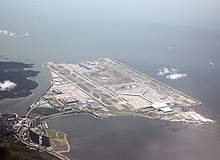
Handling 3.4 million tons of freight in 2009, Hong Kong International is responsible for more than a third of Hong Kong’s external trade. Such a volume of cargo movements could prove a logistical headache for the airport operator, but careful planning has allowed the airport to stay abreast of increasing freight traffic. The opening of ten new cargo stands in 2007 takes the airport’s total up to 34. Technological innovations and further expansion plans will ensure the airport stays one step ahead of future rises, as Alex Kam explains.
Mark Brierley: What logistical challenges does Hong Kong International face when dealing with such a large volume of air cargo?
Alex Kam: Hong Kong International Airport (HKIA) has been the world’s busiest international cargo airport since 1996, with a throughput of 3.35 million tons last year.

Discover B2B Marketing That Performs
Combine business intelligence and editorial excellence to reach engaged professionals across 36 leading media platforms.
With such a large cargo volume, we need to make sure all cargo items are handled efficiently within the limited land available for cargo operations on the 1,255ha airport island, and overcome the airport’s distance from its cargo source in the Pearl River Delta (PRD) region.
To improve our cargo handling process, we have set up and chaired a Cargo Facilitation Committee involving the air cargo industry to regularly review and monitor the operation of the cargo terminals at HKIA. The committee is also tasked with helping streamline air cargo handling processes.
MB: What technology is used to ensure these challenges are overcome? Are there IT solutions available to ensure smooth ground operations?
AK: We actively explore new technology to maximise land use and operational efficiency. All our cargo terminal operators are equipped with state-of-the-art systems to streamline handling processes for information and physical cargo flow. For example, HKIA is one of the first five airports to inaugurate the implementation of e-freight, an IATA initiative aiming to take paper out of air cargo.
HKIA is now 100% e-Airwaybill (e-AWB) ready. e-AWB is the interchange of electronic data to conclude the contract of carriage, skipping the use of a paper air waybill. Among its various benefits, e-AWB enables greater accuracy and real-time access to air waybill data, and reduces possible delays in shipment handling caused by missing or illegible paper air waybill.

US Tariffs are shifting - will you react or anticipate?
Don’t let policy changes catch you off guard. Stay proactive with real-time data and expert analysis.
By GlobalDataThe Hong Kong Customs and Excise Department (C&ED) has also introduced an air cargo clearance system (ACCS) to provide direct system interface with local cargo operators for the exchange of cargo data and customs clearance instructions. This system enables C&ED to perform pre-arrival clearance of air cargo, reducing the dwell time of air cargo and the waiting time of customers collecting air cargo at the air cargo terminals. This, in turn, reduces the resources and land requirement.
On our linkage with the PRD, arrangements have been made to allow authorised providers to offer cross-boundary bonded truck services to the Chinese mainland. A designated Marine Cargo Terminal is also available to facilitate multimodal air-sea / sea-air cargo services between HKIA and PRD.
MB: The airport is served by 34 cargo stands and operated by seven different partners; how are these effectively marshalled on the ground?
AK: There are currently 34 cargo stands at HKIA and they are all centrally managed by the Airport Authority Hong Kong (AA). To optimise their usage, the AA will allocate the use of each stand according to the nature of the flight, aircraft turnaround time and real-time operation variables, etc.
The AA is also responsible for overseeing operation of the parking stands, such as helping to coordinate the activities of different franchisees and licensees, who are appointed by airlines to provide cargo loading, aircraft maintenance, refuelling and other ground services. We have also established guidelines on apron procedures to make sure a high level of safety and operation efficiency can be achieved and maintained.
MB: How is the security and efficiency of air cargo operations maintained given its scale? How is this integrated with passenger services?
AK: At HKIA, an aircraft operator is responsible for taking all measures to ensure any items, including cargo, courier, express parcels and mails on board, do not contain a restricted article that may jeopardise the safety of the aircraft. Besides, X-ray machines equipped with an explosive detection function are also in place for baggage screening.
MB: Is there scope for further expansion in Hong Kong International’s air cargo operations?
AK: We are constantly committed to improving our facilities and services. To cater for the medium-term demand, we are studying the midfield expansion. The midfield expansion programme will be implemented in phases and the handling capacity of the airport will be increased to 70 million passengers and six million tons of cargo per year, meeting the expected traffic demand up to 2020.
To be completed in two phases, a total of 20 bridge-served stands and ten operational stands will be available in the midfield area by 2020. Freighters can also park at the new operational stands.
A new cargo terminal is now under construction by Cathay Pacific Services Limited. The new cargo facility will have an annual cargo handling capacity of 2.6 million tons, bringing the total designed cargo handling capacity at HKIA to 7.4 million tons per year in 2013.
Also, to enhance the connectivity with the PRD and facilitate air cargo flows between HKIA and the PRD, two strategic road links, the HK-Zhuhai-Macao Bridge and the Tuen Mun-Chek Lap Kok Link, are under construction and will be ready by 2015/16.





